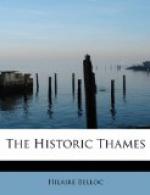Davis, one would hope—in that seventeenth century which was so essentially the century of the squires, and in that generation also wherein the squires wiped out what was left of the Crown and left the King a salaried dependant of the governing class—Davis might surely have attempted to found a family and to achieve some sort of dignity of tradition. He probably made no such an attempt, but if he did he failed; for only half-a-century later the unfortunate place changes hands again, and the Davises sell it to the Breedons.
The Breedons showed greater stability. They are actually associated with Pangbourne for over a century, but even this experiment in lineage broke down, through the extinction of the direct line. In 1776, by a sham continuity consonant to the whole recent story of English land, it passes to yet another family on the condition of their assuming the name of Breedon—which was not their own.
All up and down England, and especially in this Thames Valley, which is in all its phases so typical and symbolical of the rest of the country, this stir and change of tenure is to be found, originating with the sharp changes of 1540, and continuing to our own day.
Anywhere along this Berkshire shore of the Thames the process may be traced; even the poor little ruined nunnery of Ankerwike shows it. The site of that quiet and forgotten community was seized under Edward VI. by Smith the courtier. Then you find it in the pockets of the Salters, after them of the Lysons. The Lysons sell it to the Lees, and finally it passes by marriage to the Harcourts.
The number of such examples that could be taken in the Valley of the Thames alone would be far too cumbersome for these pages. One can close the list with Sonning.
Sonning, which had been very possibly the see of an early bishopric, and which was certainly a country house of the Bishop of Salisbury, did not pass from ecclesiastical hands by a theft, but it was none the less doomed to the same mutability as the rest. In 1574 it was exchanged with the Crown for lands in Dorset. The Crown kept it for an unusually long time, considering the way in which land slipped on every side from the control of the National Government at this period. It is still royal under Charles I., but it passes in 1628 to Halstead and Chamberlain. In little more than twenty years it is in the hands of the family of Rich. Then there is a lull, just as there was in the case of Pangbourne, and a continuity that lasts throughout the eighteenth century. But just as a tradition began to form it was broken, and in the first years of the nineteenth century Sonning is sold to the Palmers.




